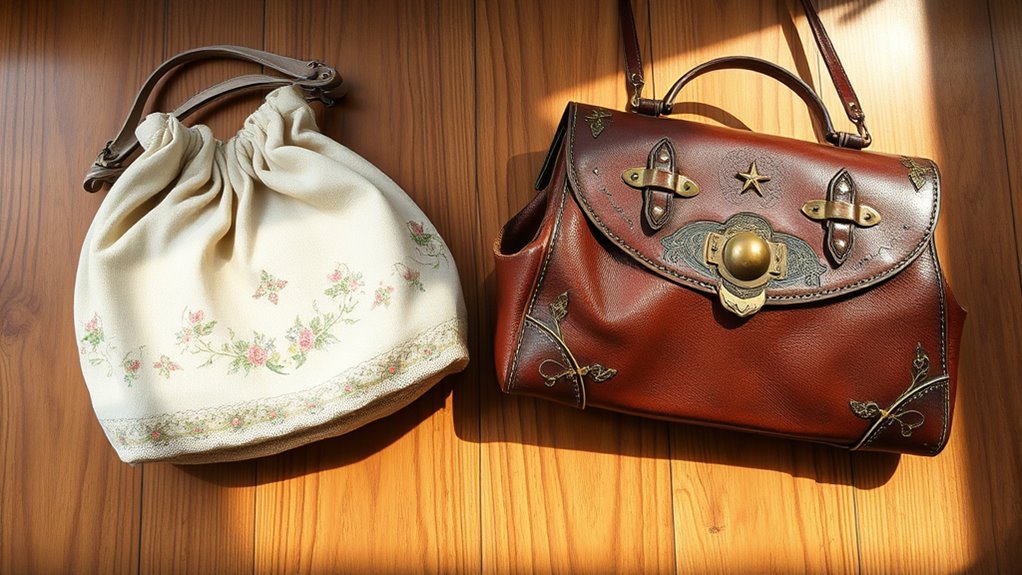To accurately date your handbags, understand that antiques are over 100 years old, with unique craftsmanship and often intricate hardware, while vintage pieces are typically 20-100 years old, reflecting specific era styles and signatures. Recognize key features like materials, hardware, logos, and stitching, and use brand markings and style trends to identify their age. Keep in mind, proper authentication and preservation help maintain value—trust that you’ll uncover more about telling vintage from antique as you explore these details further.
Key Takeaways
- Determine if the handbag is over 100 years old to classify it as antique, or between 20-100 years for vintage.
- Examine hardware, craftsmanship, and materials; antique bags often feature intricate handwork and natural, high-quality materials.
- Check for maker’s marks, serial numbers, or brand stamps that indicate specific manufacturing periods.
- Recognize era-specific design features, such as logo styles, hardware details, and overall silhouette, to date the handbag.
- Use reference guides and expert authentication tools to verify age based on style signatures and production markings.
Defining Vintage and Antique: What’s the Difference?
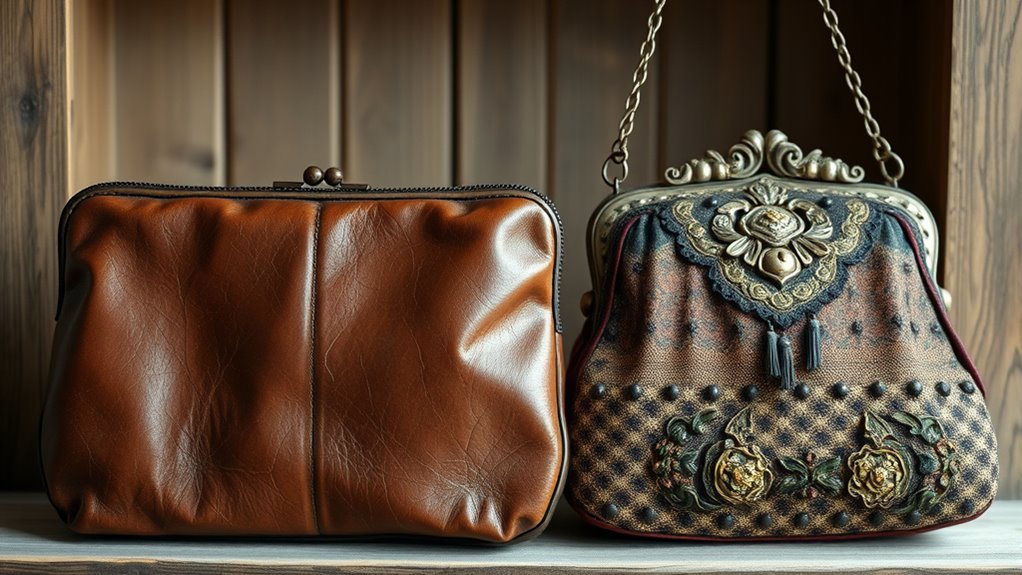
Have you ever wondered what truly sets vintage items apart from antiques? When it comes to handbags, vintage refers to pieces typically between 20 and 100 years old, often reflecting modern handbag trends of their time. These bags are usually from luxury handbag brands that remain popular today, like Chanel or Louis Vuitton, but showcase a distinct era’s style. On the other hand, antiques are generally over 100 years old and carry a sense of historical significance. They often have unique craftsmanship or materials no longer used. Understanding this difference helps you identify whether a handbag is a stylish relic from recent decades or a rare, historical treasure. Additionally, authenticity and proper appraisal are essential in determining a handbag’s true age and value. Recognizing antique characteristics can also assist in distinguishing truly old pieces from more recent reproductions. This knowledge assures you appreciate each item’s true value and place in history, which can be crucial when considering a purchase or collection. Being familiar with vintage and antique classifications can further aid in making informed decisions about your collection or purchase.
The Historical Timeframes for Handbag Classifications
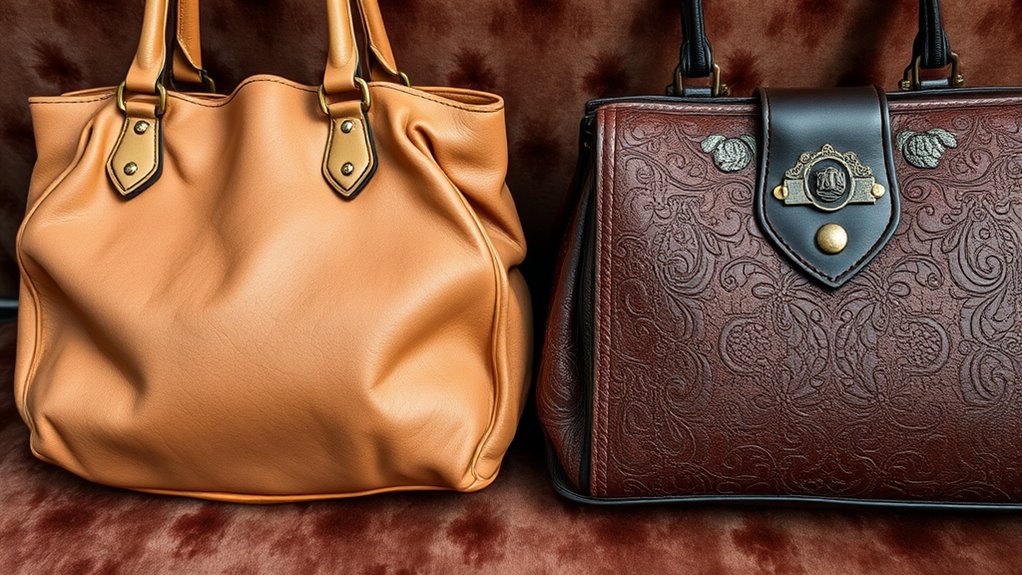
Understanding the historical timeframes helps you identify whether a handbag is vintage or antique. Vintage handbags usually showcase signatures from specific eras, like the Art Deco or 1960s styles. Antique pieces, on the other hand, are made during manufacturing periods that date back over 100 years. Recognizing inspirational quotes about fatherhood can also offer insight into the era and cultural significance of certain designs and craftsmanship.
Vintage Era Signatures
Vintage era signatures serve as key identifiers for handbags, pinpointing their production periods and stylistic influences. Recognizing these signatures helps you determine the age and authenticity of a bag, which is vital for handbag resale and collector marketplaces. For example, logos, hardware styles, stitching techniques, and material choices reflect specific decades. During the 1950s and 1960s, handbags often featured bold logos and structured shapes, while the 1970s embraced more relaxed, bohemian designs with distinctive hardware. Learning these signatures allows you to distinguish vintage pieces from modern reproductions, ensuring accurate dating. Additionally, awareness of product trends during different eras can further aid in authenticating and dating handbags. Understanding vintage design elements can also provide insights into the cultural influences of each period. Recognizing historical fashion influences helps contextualize the styles and features typical of each era. For instance, the use of certain materials or hardware styles can serve as vintage era signatures that date a handbag precisely. Recognizing these details can significantly enhance your ability to evaluate a handbag’s historical significance and value, making your efforts in the collector marketplace more informed and successful. Moreover, studying iconic handbag styles from various decades can deepen your understanding of the era-specific aesthetics.
Antique Manufacturing Periods
Antique handbags are generally considered to be items manufactured before the early 20th century, with their classifications often based on distinct historical periods. These periods include the Victorian, Edwardian, Art Deco, and Belle Époque eras, each reflecting unique craftsmanship and design elements. Recognizing the manufacturing period helps you accurately date your handbag and understand its value. Understanding historical context** is essential for collectors to appreciate the craftsmanship and significance of each era. While modern handbag trends focus on functionality and minimalism, antiques showcase intricate details and handcrafted quality. To preserve your collection, follow handbag storage tips like storing in a cool, dry place away from direct sunlight and using acid-free tissue paper. Knowing antique manufacturing periods allows you to appreciate the historical context and maintain your handbags’ integrity for years to come. Additionally, understanding the decluttering process involved in managing vintage collections can help you make informed decisions about preserving and displaying your handbags effectively, especially considering the importance of proper storage techniques** for long-term preservation.
Recognizing Key Features of Antique Handbags
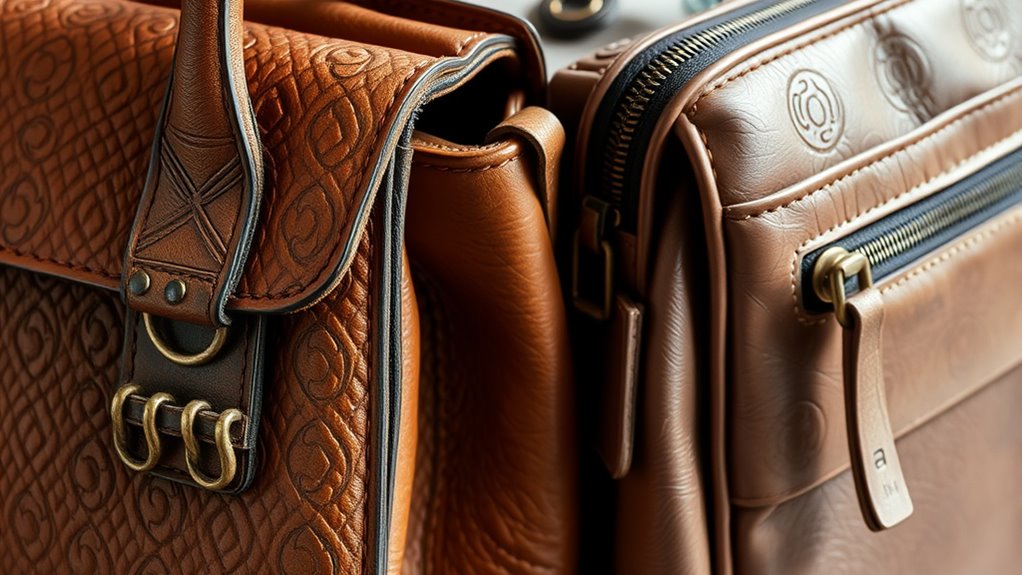
To spot an antique handbag, examine the craftsmanship and materials used, as they often reflect the skill and resources of the era. Pay close attention to the hardware and fastenings, which tend to be more intricate and made from quality metals like brass or silver. These features help distinguish genuine antiques from newer or vintage pieces. Additionally, understanding social and global issues can offer valuable insights into how to protect and preserve your collection during unforeseen events. Being aware of city dynamics and the importance of proper storage can further ensure the longevity of your handbags. Incorporating knowledge of material durability can also assist in identifying authentic antique pieces, as older materials often age uniquely and exhibit specific wear patterns. Moreover, being aware of regional bank hours and how they vary can help in planning visits for appraisals or acquisitions.
Craftsmanship and Materials
Recognizing the craftsmanship and materials of antique handbags requires a keen eye for detail, as these items often showcase techniques and materials that are rare today. You might notice hand-stitched seams, intricate embroidery, or embossed leather that reflects the skill of artisans from bygone eras. The use of high-quality, natural materials like fine leather, silk linings, or exotic skins signals craftsmanship that’s hard to find now. Rare designer handbags often feature unique craftsmanship details, making them valuable for handbag restoration or collection. Pay attention to the overall construction—solid frames, carefully finished edges, and hand-applied embellishments. These features highlight the quality and artistry invested in antique handbags, distinguishing them from modern reproductions or mass-produced items. Additionally, authenticity indicators such as maker’s marks or serial numbers can help verify their age and provenance. Understanding electric power generation can also provide insight into how materials used in vintage handbags were sourced and produced sustainably.
Hardware and Fastenings
How can you identify the age and authenticity of an antique handbag? Focus on hardware details and fastening styles. Antique handbags often feature metal hardware made from brass, silver, or gold, with signs of wear like tarnishing or patina, indicating age. Look closely at the clasps, buckles, and locks—older fastening styles tend to be sturdy, intricate, and sometimes engraved, reflecting craftsmanship. Modern reproductions may use lightweight, plated metals or have machine-made details. Authentic antique bags often have hand-set hardware with unique marks or maker’s stamps. Pay attention to how the hardware is attached; hand-sewn or soldered fastenings point to older manufacturing techniques. Recognizing these subtle differences helps verify the handbag’s period and adds confidence to its authenticity.
Identifying Characteristics of Vintage Bags
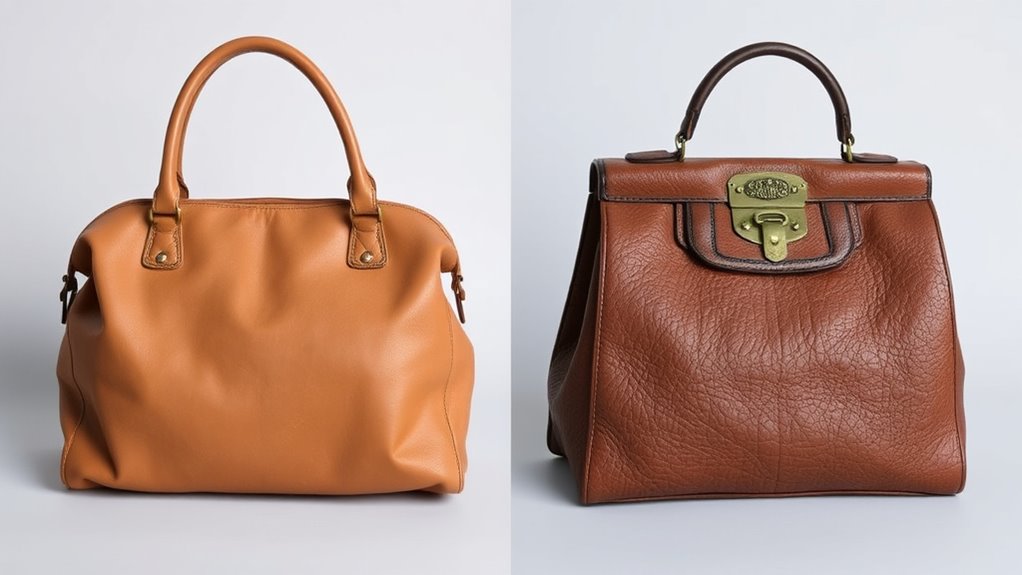
Vintage bags often showcase distinctive features that set them apart from modern designs, making them easier to identify if you know what to look for. Look for craftsmanship details like hand-stitched seams, natural leather patina, and unique hardware. These elements reflect the craftsmanship of the era and contrast with modern handbag trends, which often favor mass-produced items. Pay attention to labels, lining materials, and hardware styles, as they can reveal the bag’s age. Here’s a quick comparison:
| Feature | Vintage Bags | Modern Handbags |
|---|---|---|
| Hardware | Brass or antique finishes | Chrome or plated metals |
| Stitching | Hand-stitched or irregular | Machine-stitched |
| Leather Patina | Rich, aged look | Often synthetic or new |
| Labels | Sewn-in, classic fonts | Modern, logo-centric |
Use these clues along with handbag styling tips to better identify vintage pieces. Additionally, understanding materials used in different eras can further assist in accurate dating. Recognizing signs of wear and aging helps verify authenticity and age, especially when inspecting vintage handbags. A keen eye for hardware styles can also reveal the specific period during which the bag was made. Exploring craftsmanship details like stitching techniques and finishing touches provides deeper insight into the bag’s origin and era.
Tools and Resources for Dating Old Handbags
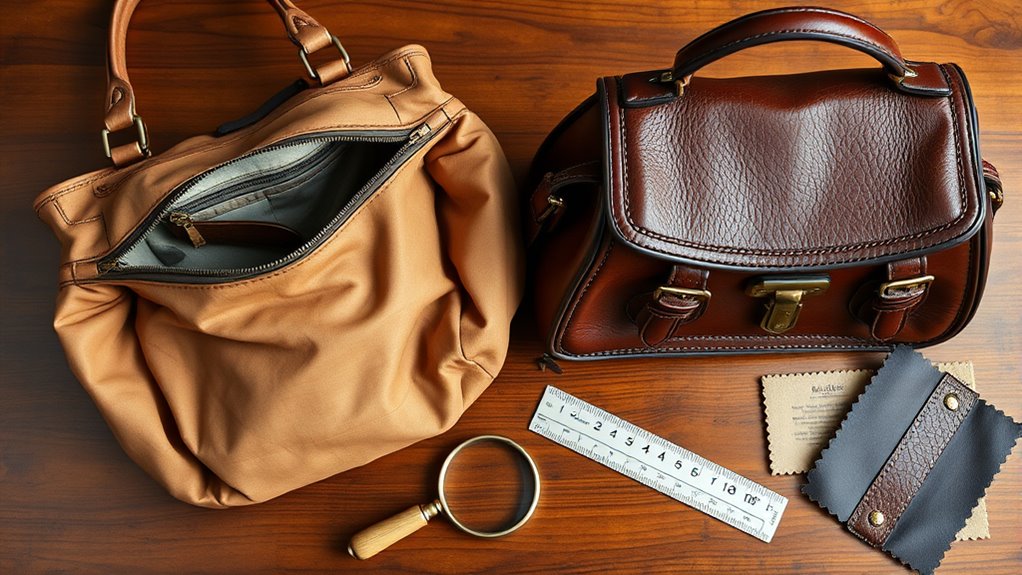
To accurately date your old handbag, you should use authenticity verification guides and reference books that specialize in vintage and antique accessories. Examining manufacturer markings and codes can also reveal important clues about its age and origin. By utilizing these tools and resources, you’ll gain a clearer understanding of your handbag’s history and value.
Authenticity Verification Guides
Ever wonder how to determine if an old handbag is truly authentic? Authenticity verification guides are invaluable tools for collectors and enthusiasts. They help you navigate market trends and avoid fakes. Here are key resources to consider:
- Reputable Reference Books – Offer detailed insights on brands, materials, and styles.
- Online Forums and Collector Communities – Share collector insights, spotting trends, and authenticating tips.
- Brand-specific Websites – Provide official info, historical data, and verified markings.
- Authentication Services – Professional appraisers and labs verify authenticity with expert analysis.
Using these guides, you gain clarity and confidence in your vintage handbag investments, aligning with current collector insights and market trends to distinguish genuine pieces from reproductions.
Manufacturer Markings and Codes
Manufacturer markings and codes serve as vital tools for dating old handbags, helping you verify their age and authenticity. These markings often include serial numbers, date codes, or factory stamps that reveal production details. By studying these codes, you can identify the handbag’s manufacturing period and confirm its originality. Different brands have unique systems, so understanding the specific marking style is essential. Use the table below as a quick reference for common manufacturer markings and dating codes:
| Brand | Typical Marking Format |
|---|---|
| Louis Vuitton | Date code with letters and numbers |
| Chanel | Logo stamped or embossed |
| Gucci | Serial number or tag |
| Prada | Metal plaque with serial numbers |
| Hermès | Blind stamp with date code |
Mastering these markings helps you accurately date and authenticate vintage handbags.
Reference and Appraisal Books
Reference and appraisal books are invaluable tools when dating and authenticating vintage handbags, offering detailed information that may not be available elsewhere. These resources help you identify genuine pieces versus faux vintage or modern reproductions. To maximize their value, focus on:
- Recognizing brand histories and timelines
- Comparing hardware, stitching, and logos
- Identifying hallmark features of specific eras
- Spotting common traits of faux vintage and reproductions
Using these books, you can better distinguish authentic vintage handbags from imitators or modern copies. They often include high-quality images, detailed descriptions, and tips for spotting counterfeit features. This knowledge helps you make informed decisions, ensuring your collection’s authenticity and value. Keep these references handy as your go-to for dating and verifying old handbags confidently.
Examining Materials and Craftsmanship Clues
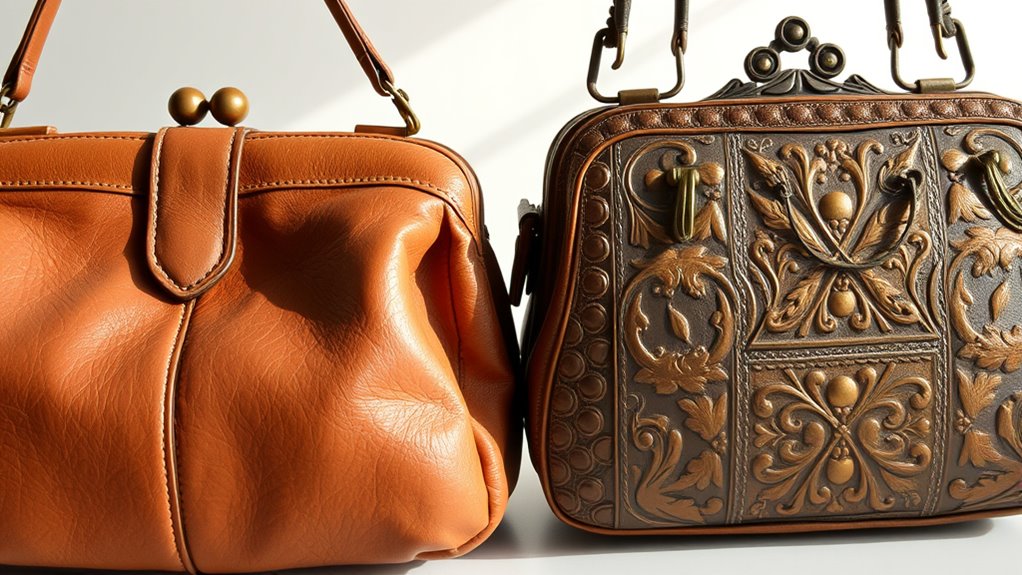
When trying to distinguish between vintage and antique items, examining the materials and craftsmanship can provide valuable clues. Start by evaluating the leather quality; antique handbags often feature thicker, more durable leather that shows signs of age, such as patina and wear patterns. Vintage pieces might have softer, more modern leather with a uniform appearance. Pay attention to stitching techniques too. Hand-stitched seams, especially with uneven or irregular stitches, suggest older craftsmanship, typical of antique bags. In contrast, machine stitching, which is more consistent and precise, is common in vintage items. Also, look at how the materials are assembled—antique handbags often display more intricate, hand-finished details, reflecting older methods, while vintage bags might use more standardized techniques.
Analyzing Branding and Markings for Dating
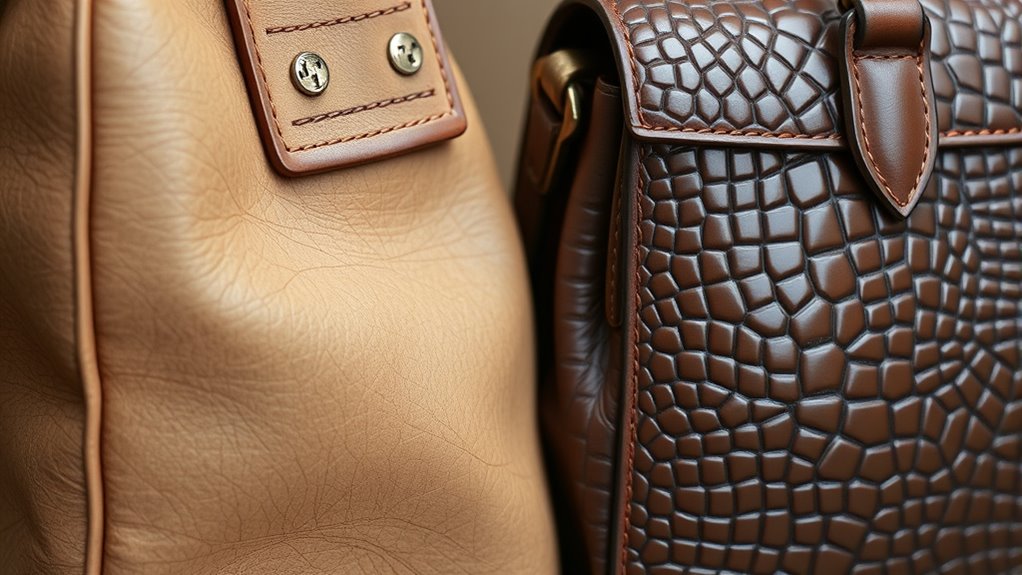
Examining the branding and markings on an item can be a crucial step in determining its age. Luxury branding and leather markings often reveal key details about when and where your handbag was made. To analyze effectively, consider these points:
Analyzing branding and markings helps identify your handbag’s age and origin.
- Logo Style: Check if the logo matches historical designs from specific eras or brands.
- Stamp Quality: Look for clear, embossed leather markings that indicate authentic manufacturing processes.
- Branding Placement: Note where the logo appears—early pieces often have logos in different spots than modern ones.
- Serial Numbers: Some brands include serial codes or date stamps that help pinpoint production years.
Understanding Fashion Trends and Design Eras

Understanding fashion trends and design eras is essential for accurately dating vintage and antique items. Recognize that handbag design reflects the style preferences of its time, so staying familiar with these trends helps you identify when a piece was made. For example, modern fashion often favors minimalism and sleek lines, which influence handbag design today. Conversely, earlier eras may feature ornate details, bold hardware, or unique materials tied to specific periods like the Art Deco or Victorian eras. By studying how handbag styles evolved and aligning them with historical fashion movements, you can better determine a handbag’s age. This knowledge allows you to differentiate between vintage and antique pieces, ensuring your dating is as precise as possible.
Tips for Authenticating Old Handbags
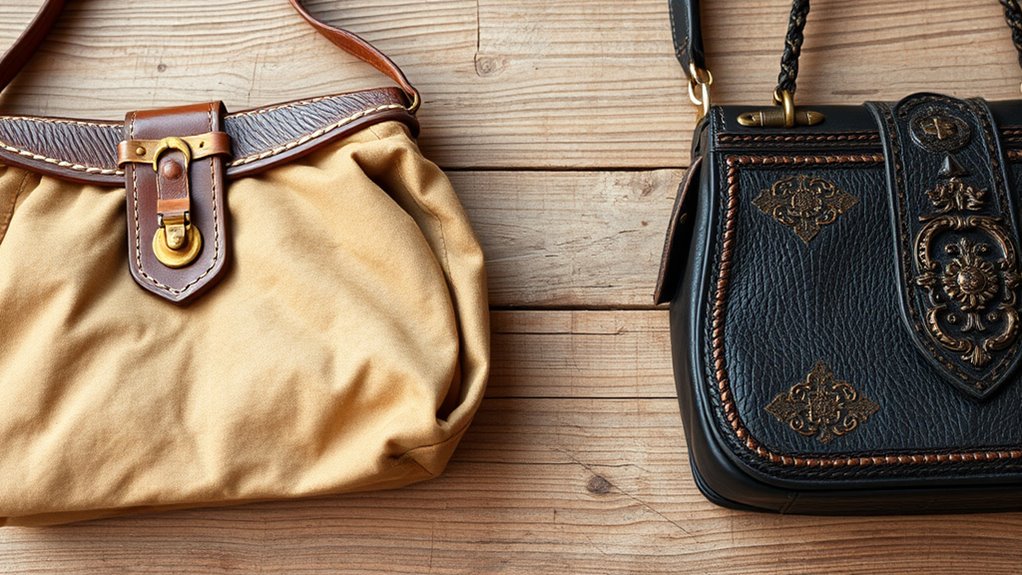
Authenticating old handbags requires attention to specific details that reveal their true age and origin. To verify authenticity, examine these key points:
- Material and craftsmanship – Authentic vintage and antique bags often feature high-quality leather, textiles, or hardware, reflecting their era’s craftsmanship.
- Serial numbers and stamps – Check for maker stamps, serial numbers, or date codes, which help confirm age and origin.
- Hardware and hardware markings – Look closely at zippers, clasps, and hardware for markings or logos, indicating genuine pieces.
- Signs of bag restoration – Be cautious of overly pristine sections or recent repairs that might boost resale value but hide original flaws.
Mastering these tips helps ensure your handbag’s authenticity, supporting proper bag restoration efforts and maintaining or increasing its resale value.
Preserving and Caring for Vintage and Antique Bags
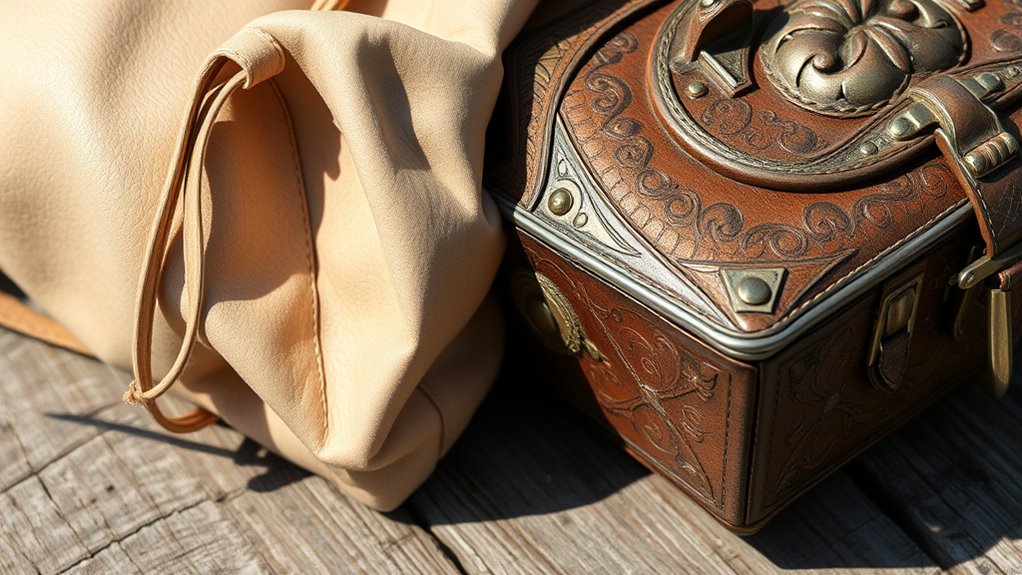
Caring for vintage and antique bags requires consistent attention to prevent deterioration and preserve their value. Proper maintenance includes regular cleaning, gentle leather restoration, and smart handbag storage tips. Store your bags in a cool, dry place away from direct sunlight to prevent fading and cracking. Use acid-free tissue paper to maintain shape and avoid dust buildup. When cleaning leather, opt for a soft cloth and specialized leather conditioner. Avoid plastic covers that trap moisture. Here’s a quick guide:
| Storage Tip | Explanation |
|---|---|
| Keep in a dust bag | Protects from dust and light damage |
| Avoid sunlight | Prevents fading and leather drying |
| Maintain humidity levels | Prevents cracking and mold |
| Use padding inside bags | Keeps shape and prevents deformation |
| Regularly inspect bags | Spot early signs of damage for timely leather restoration |
Frequently Asked Questions
How Can I Distinguish Between a Genuine Antique and a Reproduction Handbag?
To distinguish a genuine antique handbag from a reproduction, start by examining authentication marks, which can indicate age and origin. Next, perform material analysis—authentic antiques often use specific fabrics, leathers, and hardware consistent with their era. Look for signs of wear and craftsmanship details, as reproductions may lack the fine finishing or show modern manufacturing traits. Combining these methods helps you verify the handbag’s authenticity effectively.
What Are Common Signs of Restoration or Repair in Antique Handbags?
Imagine a delicate tapestry showing signs of wear, yet still beautiful—this is what to look for when spotting restoration signs. You’ll notice repair indicators like mismatched stitches, uneven leather, or visible glue. These repair indicators hint at past restorations, helping you distinguish between original craftsmanship and later repairs. Spotting these signs allows you to appreciate the handbag’s history and authenticity, revealing whether it’s a genuine antique or has been altered over time.
Are There Specific Countries Known for Producing More Authentic Vintage Handbags?
You might notice that certain countries are renowned for authentic vintage handbags due to their rich regional craftsmanship. For instance, Italy and France are famous for luxury brands that produce high-quality, genuine vintage pieces. These countries have a long history of skilled artisanship, making handbags from these regions more likely to be authentic. Always check labels, craftsmanship details, and brand reputation to verify authenticity, especially when exploring vintage luxury handbags.
How Does Wear and Patina Help in Dating Old Handbags Accurately?
You can date old handbags accurately by examining wear and patina. Age-related deterioration, like softened leather or worn edges, reveals the handbag’s age. Surface patina, which develops over time, shows color changes and a smoother feel on high-contact areas. These signs help you estimate the handbag’s age, as genuine vintage pieces display authentic wear that differs from newer reproductions, giving you clues about their true period.
Can Modern Techniques Accurately Date Vintage Handbags Beyond Visual Inspection?
Sure, modern tech makes dating vintage handbags seem effortless, but don’t be fooled. Techniques like carbon dating and material analysis can help, but they’re not foolproof for small items like bags. You might think you’re getting precise ages, but often, these methods are limited by the materials used. So, while high-tech tools add to your arsenal, don’t forget that expert visual inspection still plays a vital role.
Conclusion
Now that you know how to distinguish vintage from antique handbags, you’re better equipped to appreciate their true value. Remember, the key is careful observation and research. Will you trust your instincts or overlook the details that make each bag unique? By understanding their history and features, you can confidently date and authenticate your collection. So, are you ready to uncover the stories behind your vintage and antique handbags?
